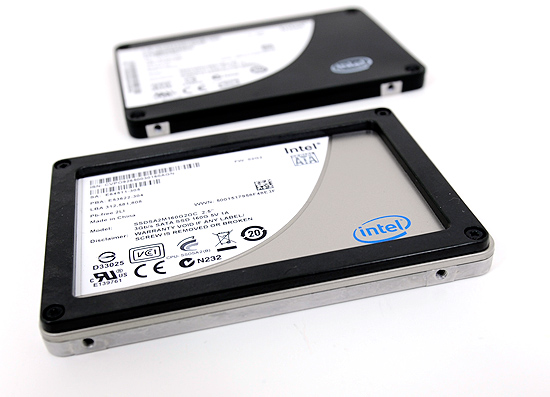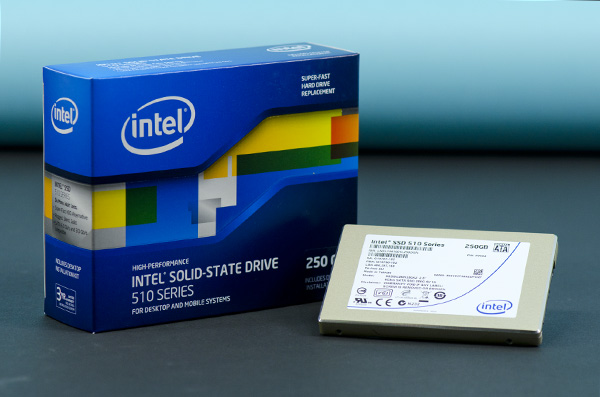The Intel SSD 510 Review
by Anand Lal Shimpi on March 2, 2011 1:23 AM EST- Posted in
- IT Computing
- Storage
- SSDs
- Intel
- Intel SSD 510
The X25-M was a tremendous first attempt by Intel to get into the SSD market. In our review of the SSD I wrote that Intel just Conroe’d the SSD market, and if it weren’t for the pesky 80MB/s sequential write speed limitation the X25-M would’ve been given the title: World’s Fastest Drive.

Its successor, the X25-M G2, was a mild update that brought prices down through the use of 34nm NAND. Remember that Intel is also 49% owner of the IMFT joint venture and as a result can be quite competitive on NAND pricing (and quite early to adopt new NAND technologies).

Intel’s goal all along was to drive down the cost of SSDs. Looking at the history of MSRPs with the X25-M (not to mention the M, which stood for Mainstream in the product name) this shouldn’t come as a surprise:
| Intel X25-M Pricing History | |||||
| 2008 | 2009 | ||||
| 40GB | - | $125 | |||
| 80GB | $595 | $225 | |||
| 160GB | $1000+ | $440 | |||
The third generation X25-M was to drive down costs even further, this time thanks to Intel’s 25nm NAND. You’d be able to get twice the capacity at the same price point as the X25-M G2. The value drive would be an 80GB offering, the mainstream drive would be 160GB and the high end drive would be 320GB.
The drive would offer higher performance. The controller was to be completely redesigned, with the “oversight” that limited sequential write speed to only 100MB/s corrected entirely. In addition, the third generation Intel SSD would add full disk encryption - making it even better suited for enterprise customers. Going after the enterprise market was Intel’s plan to really make money on SSDs in the long run. Instead of just selling corporations a CPU, chipset and wireless controller in a notebook, there would be an SSD on top of all of that. Perhaps eventually even have some security software courtesy of McAfee.
The third generation X25-M was originally due out in the middle of 2010. As is usually the case with schedules, the “G3” slipped. The middle of the year became the end of the year and the end of the year became Q1 2011.
To make matters worse, the specifications Intel was talking about for its third generation drive/controller weren’t all that competitive. We published the details last year knowing that the competition would do better. Intel’s redesigned controller was late and underperforming. Internally, Intel knew it had a problem.
Intel aimed for the majority of the market with the X25-M, it had set its sights on lowering cost, but it left the high performance enthusiast market entirely uncared for. A void that SandForce filled quite nicely with its unique brand of controllers.
With a hole in the roadmap and an unwillingness to cede complete control of the high end market to SandForce, Intel did the unthinkable: developed a new SSD based on a competing controller technology.











128 Comments
View All Comments
AnnihilatorX - Wednesday, March 2, 2011 - link
Anand you didn't clarify very clearly what is the difference of naming between 510 series and X-25 G3.The introduction leads me to believe 510 is X-25 G3, or is it not?
Is X-25 G3 going to use 25nm flash instead, so it's another drive? If so, when is the release date of that, and how do we expect its performance compared to 510 in this review? Will the X-25 G3 uses a custom controller?
strikeback03 - Thursday, March 3, 2011 - link
As the article stated, the G3 (whatever it is officially called) will be a lower-performance part whose aim is to bring lower prices and better reliability to more mainstream segmentsMrStromberg - Wednesday, March 2, 2011 - link
So I've been waiting for quite some time now for the new intel drives since the reviews in the past about how reliable and how long life an SSD has, promising that all of this would be better with these new generation drives. Although now I am faced with the potential "problem" of a 3Gbit bottle neck in mi macbook pro and as mentioned in the review above "these next-generation SSDs not only use 6Gbps SATA, they really need it." So where does that leave me? Should a go for a cheaper older drive which might be less reliable in the long run (but nobody really knows right?) or buy a new generation drive which might be suffering from a bottleneck? I didn't really understand why the new drives really need the 6Gbit SATA to function well? Can someone please explain or give me some advice.thank you
Denithor - Wednesday, March 2, 2011 - link
Best right now would probably be an Intel G2 drive. Fast enough and very good durability.The next generation drives aren't really going to perform much better on a 3Gb SATA port than the current generation already does, plus you have the worse durability inherent in the 25nm NAND chips.
Nentor - Wednesday, March 2, 2011 - link
Wow, so Intel has a gap in it's road map and goes the 3rd party route and brings us a product that is essentially slower than a consumer product (Vertex 3) from another manufacturer.They could have gone Sandforce, why not?
mateus1984 - Wednesday, March 2, 2011 - link
http://forums.hexus.net/general-discussion/199892-...Drag0nFire - Wednesday, March 2, 2011 - link
Would love to see you run a traditional hdd through the new bench so we can see what sort of real world improvements can be expected from making the switch to an SSD...Great article. I'll be waiting for the x25-m G3. Keep on Intel about this!
wheel - Wednesday, March 2, 2011 - link
Thanks for the review Anand, but I am a little disappointed that there are a lot of synthetic benchmarks but no real world tests.By "real world tests" I mean separate tests for: booting into Windows; loading a web browser with 25 tabs of saved web page documents on the HDD; starting Star Craft and loading a map; copying a large amount of files to itself; running a batch Photoshop image transform job; starting IE6 from a stopped Windows XP Mode VM and opening a complex web page hosted on the local disk; running a intensive anti-virus scan on a specific (large) folder etc.
I know PC Mark and SysMark are meant to represent these real world test, but as individual consumers we have different usage profiles and by breaking down the results into individual tests we can better work out which drive is most appropriate for us, instead of studying the synthetic tests and making an educated guess.
Cheers,
Ian
Boogaloo - Wednesday, March 2, 2011 - link
Seconded.A lot of people are complaining about the performance of the drive, and I'd like to know how much of a difference it actually makes in real world scenarios. If this drive comes within 10 ms of a vertex 3 loading up starcraft 2, then who cares?
iwod - Wednesday, March 2, 2011 - link
If you read carefully the Anand Benchmarks does exactly just that.